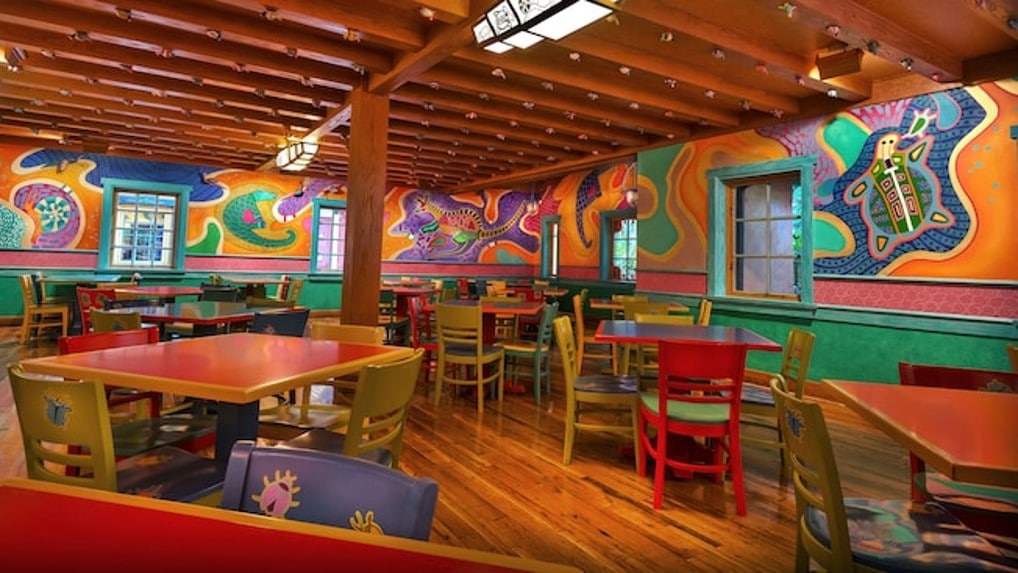A Friday Visit with Jim Korkis: Safari Village at Disney’s Animal Kingdom
By Dave Shute
Welcome back to Fridays with Jim Korkis! Jim, the dean of Disney historians, writes about Walt Disney World history every Friday on yourfirstvisit.net.
SAFARI VILLAGE AT DISNEY’S ANIMAL KINGDOM
By Jim Korkis
Safari Village was meant to be the thematic heart of Disney’s Animal Kingdom and serve as the central hub. Encircled by Discovery River, Safari Village [renamed Discovery Island in December 2010–Dave] was a lush, green island that serves as a magical departure point for each of the different realms of the park.
As the original promotional material stated, Safari Village
“… is a mix of tropical and equatorial styles featuring references to the Caribbean but also Polynesian influences. Strong, bright colors dominate the landscape. Animal forms decorate every possible surface of the one-story structures smothered in many-hued tropical foliage.
“A unique vocabulary of animal images, inspired by folk art from around the world, gives the Village a playful look that celebrates the beauty and power of animals. Safari Village’s shops make it the natural center of the park. It’s also the ideal place to encounter a unique brand of live entertainment celebrating the special connection between humans and animals.”
Safari Village has folk art inspired forms on every available surface including walls, ceilings, windowsills, gable ends and more.
The buildings are not just ornamented with animals, but also each facility has its own theme. Island Mercantile features animals that migrate and work – whales and wildebeests, bees and beavers. Creature Comforts features animals with stripes and spots. Beastly Bazaar has animals from fresh and salt water cavorting throughout it.
The clever theme of the Flame Tree Barbecue restaurant is predator and prey – prey are painted on the tables and predators on the chairs. Pizzafari’s dining rooms each have different themes. One room is dedicated to animals that hide in their environment. Another room is dedicated to animals that carry their houses on their backs like turtles, snails and hermit crabs. One room is based on animals that hang upside down.
For Safari Village, Imagineer Joe Rohde wanted to create a place no one had ever seen before. There are nine separate color schemes on Pizzafari alone.
“Jenna Goodman and I said, ‘You want it bright? We can do bright’.” said senior show designer Katie Olson. “When we did color design for Harambe we pored over books of photographs, trying to make sure we were rendering exact copies of a village in Kenya.
“Safari Village has a little bit of a tropical feelings but we just said, ‘I think lime green would look really good with this color’ and we tried it. At first, it was a little difficult breaking all the rules, but once we got into the rhythm of it, it became a really fun project.
“It didn’t have to be recognizable as anywhere in particular and that gives you a lot of freedom. But you have to still respect the form of the architecture. We used a lot of Caribbean color and references like Mexican wedding dresses and Oaxacan carved animals. If the color design successfully supports the overall story we are telling, the environment becomes that much more magical for our guests.”
Designers journeyed to Mexico to find basket weavers who could fashion wicker kangaroos to hold merchandise. In Oaxaca, Mexico, four hours down a dirt and boulder road, they found a family that carves and paints fantastically shaped animals. Imagineers ordered 300 bats, 120 bugs and 150 butterflies to hang in Pizzafari.
Principal production designer Ken Gomes actually relocated to Bali to oversee the production of more than one hundred hand-carved articles that were shipped to Florida for the Animal Kingdom each month. Gomes became part of village life, attending weddings and funerals and acquiring the native name of Wayan (“second-born”) Sin Ken Ken (“no problem”).
“The sense of community is refreshing,” said Gomes. “The talent and skill in Bali are incredible resources. They don’t realize how gifted they are.”
* * * * *
Thanks, Jim! Safari Village was renamed Discovery Island in December 2000, obviously because of the Discovery River but perhaps partly in homage to the old area of this name between the Contemporary Resort and the Wilderness Lodge.
And come back next Friday for more from Jim Korkis!
In the meantime, check out his books, including his latest, Call Me Walt, and his Secret Stories of Walt Disney World: Things You Never You Never Knew, which reprints much material first written for this site, all published by Theme Park Press.
Follow yourfirstvisit.net on Facebook or Twitter or Pinterest!!






0 comments
Comment by typing in the form below.
Leave a Comment | Ask a Question | Note a Problem